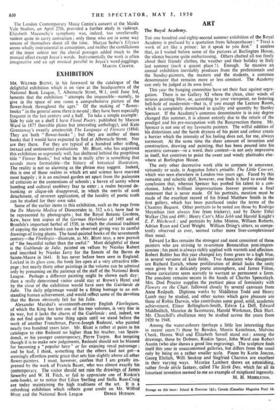EXHIBITION
MR. WILFRID BLUNT, in his foreword to the catalogue of the delightful exhibition which is on view at the headquarters of the National Book League, 7, Albemarle Street, W.1, until June 3rd, laments that the exhibition " attempts the impossible—namely, to give in the space of one room a comprehensive picture of the flower-book throughout the ages." Of the making of " flower- books " in the general sense there is no end ; they have been especially frequent in the last century and a half. To take a simple example : Side by side on a shelf I have Floral Poetry. published by Marcus Ward in 1877 (horrible plates but interesting anthology), and Kate Greenaway's sweetly amateurish The Language of Flowers (1884). They are both " flower-books " ; but they are neither of them books that I would have expected to find at Albemarle Street. Nor are they there. For they are typical of a hundred other trifling, inexact and sentimental productions Mr. Blunt, who has organised this exhibition so supremely well, has sheltered behind the propitious title " Flower Books," but what he is really after is something that sounds more formidable—the history of botanical illustration. The reality is not so alarming as the phrase may suggest. Indeed, this is one of those realms in which art and science have married most happily ; it is an enclosed garden set apart from the jealousies of criticism or the contentions of schools ; a haven of sanity where humbug and cultural snobbery fear to enter ; a realm beyond de- bunking or clique-ish disapproval, in which the merits of cool detachment, of reverent application, of the lucidity of poetic truth can be studied for their own sake.
Some of the earlier items in this exhibition, such as the page from the De Materia Medico of Dioscorides (c. 512 A.D.), have had to be represented by photographs ; but the Royal Botanic Gardens, Kew, have lent copies of the German Herbarius of 1485 and of Brunfels's important herbal of 1530, in which the classical tradition of copying the ancient books can be observed giving way to careful drawings of living plants. The hand-painted books of the seventeenth century—the Florllegia—illustrate, as Mr. Blunt says, a new pursuit of " the beautiful rather than the useful." Most delightful of these is the Guirlande de Julie, painted on vellum by Nicolas Robert and inscribed by Nicolas Jarry for the fiancee of the Baron de Sainte-Maure in 1641. It has never before been seen in England. Locked in its glass case, the book lies open at a very attractive title- page ; but nearly thirty other paintings in the volume can be admired only by presuming on the patience of the staff of the National Book League. Perhaps a different painting might be shown each day: then a really determined visitor could stay at Brown's Hotel and by the close of the exhibition would have seen the Guirlande de Julie. The daily pilgrimage would be a fitting homage to an out- standing human achievement, and would reflect some of the devotion that the Baron obviously felt for his Julie.
Alexander Marshal's seventeenth-century English Florilegium, of which the King has lent one of his two volumes, is very fine in its way, but it lacks the charm of the Guirlande ; and, indeed, we do not find quite the same thing again until we stand before the work of another Frenchman, Pierre-Joseph Redoute, who painted nearly two hundred years later. Mr. Blunt is rather at pains in his catalogue to ate Redoute no higher than his teacher, van Spaen- donck, or his younger contemporary, Pierre Turpin. But tempting though it is to make new judgements, Redoute should not be blamed for becoming a " popular hero " or for enjoying royal patronage ; and he had, I think, something that the others had not got—a seemingly effortless poetic grace that sets him slightly above all other flower-painters. I must, however, confess that I am greatly im- pressed by the work of Francis Bauer, who was almost exactly his contemporary. The visitor should not miss the drawings of James Sowerby and W. H. Fitch, or fail to appreciate one of Ruskin's note-books, or to notice that Lilian Snelling and Stella Ross-Craig are today maintaining the high traditions of the art. It is a refreshing exhibition which reflects great credit on Mr. Wilfrid
Blunt and the National Book League. DEREK HUDSON.






































 Previous page
Previous page